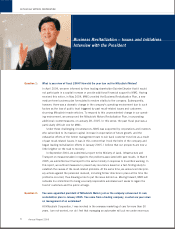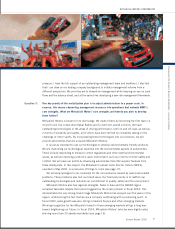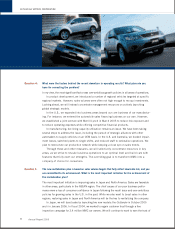Mitsubishi 2005 Annual Report Download - page 18
Download and view the complete annual report
Please find page 18 of the 2005 Mitsubishi annual report below. You can navigate through the pages in the report by either clicking on the pages listed below, or by using the keyword search tool below to find specific information within the annual report.
Annual Report 2005
16
MITSUBISHI MOTORS CORPORATION
■ Basic R&D Policies
MMC is pursuing R&D activities with the view to realizing the
aspirations of the new corporate philosophy formulated in
conjunction with the announcement of the Mitsubishi Motors
Revitalization Plan in January 2005. In essence, this means
that the most significant mission of R&D at MMC is to
continue to deliver without comprise the “Utmost Driving
Pleasure” and “Safety” for “Valued Customers and Our
Community.” More specifically, MMC is striving to achieve
this goal based on the following three key themes:
“For Valued Customers and Our Community”
Develop automobiles with improved fuel efficiency and
low emissions, low-pollution vehicles, and easily recy-
clable vehicles with no hazardous substances with the aim
of protecting the environment.
“The Utmost Driving Pleasure”
Develop high-performance powertrains and four-wheel
control technologies, as well as technologies for lowering
the center of gravity and reducing the weight of vehicles.
“Safety”
Develop body frame structures and safety features that
protect passengers, and interior materials that achieve
more comfortable cabin spaces.
<Concrete Initiatives>
Based on the above basic policies, approximately 4,000
R&D staff members across the MMC Group are working to
develop a variety of new technologies.
•MMC is enhancing its lineup
of high-performance, low
fuel consumption,
powertrain systems. This
lineup includes a recently
developed MIVEC aluminum
cylinder block engine, CVT
(Continuously Variable
Transmission) and AMT
(Automated Manual Trans-
mission). These efforts are being made to respond to new
fuel economy standards that will come into force in Japan
in 2010 as well as a new certification system for low-
emission vehicles. In parallel, MMC is working to meet
overseas regulatory developments such as the tightening
of CAFE standards in the U.S., the launch of the ZEV
program in California, and voluntary targets for reducing
CO2 emissions in Europe.
•As part of initiatives to create propriety environmental
technologies, MMC is pursuing the development of next-
generation electric vehicles. These vehicles are based on
two core technologies: in-wheel motors, which enable the
drive system to be housed compactly, and lithium-ion
batteries, which offer superior energy density. Collectively,
these technologies and vehicles are referred to as the MIEV
(Mitsubishi In-wheel motor Electric Vehicle) concept. MMC
is pressing ahead with technological development with the
view to pursuing the exciting new possibilities of electric
vehicles while also applying these technologies to hybrid
and fuel cell vehicles in the future. Through these initia-
tives, the company is setting its sights on manufacturing
cars befitting the current Century of the Environment.
•In the field of safety, MMC is developing technologies in
areas such as passenger and pedestrian protection, and
compatibility, as well as advancing R&D in the safety of
structural frameworks during collisions. Active safety
measures include the development of electronics designed
to anticipate and prevent accidents and driving support
technologies such as parking assistance systems, in
addition to the improvement of fundamental aspects of
driving performance such as braking and steering.
•Technologies are also being developed to make cabin
environments more comfortable. These include low-VOC
interior materials (VOCs: volatile organic compounds
responsible for “sick-house” syndrome.), the removal of
odors, pollen and other allergens, and UV and infrared
blocking technologies.
New 2.4 liter, 4-cylinder MIVEC
engine fitted on the
Outlander
























